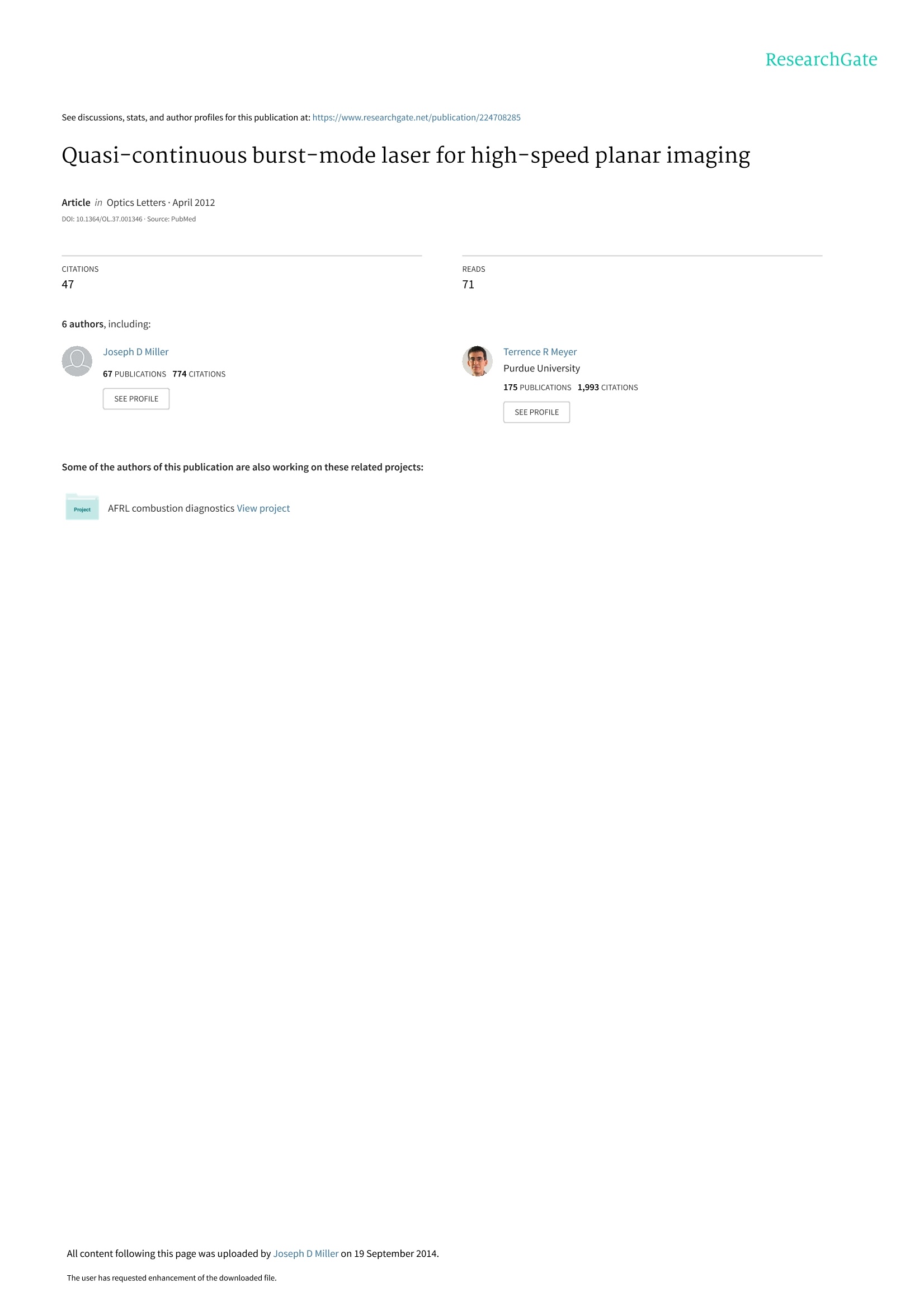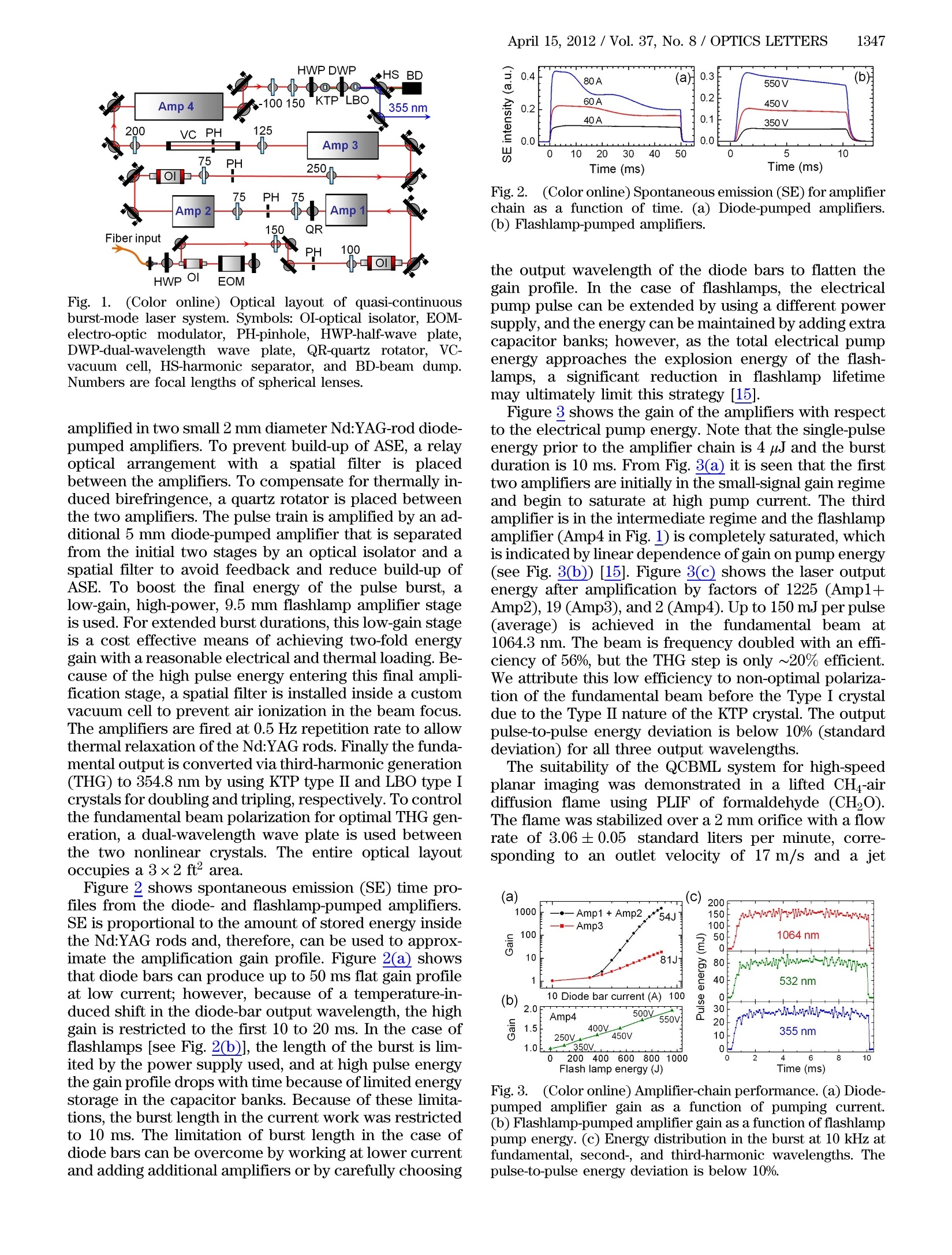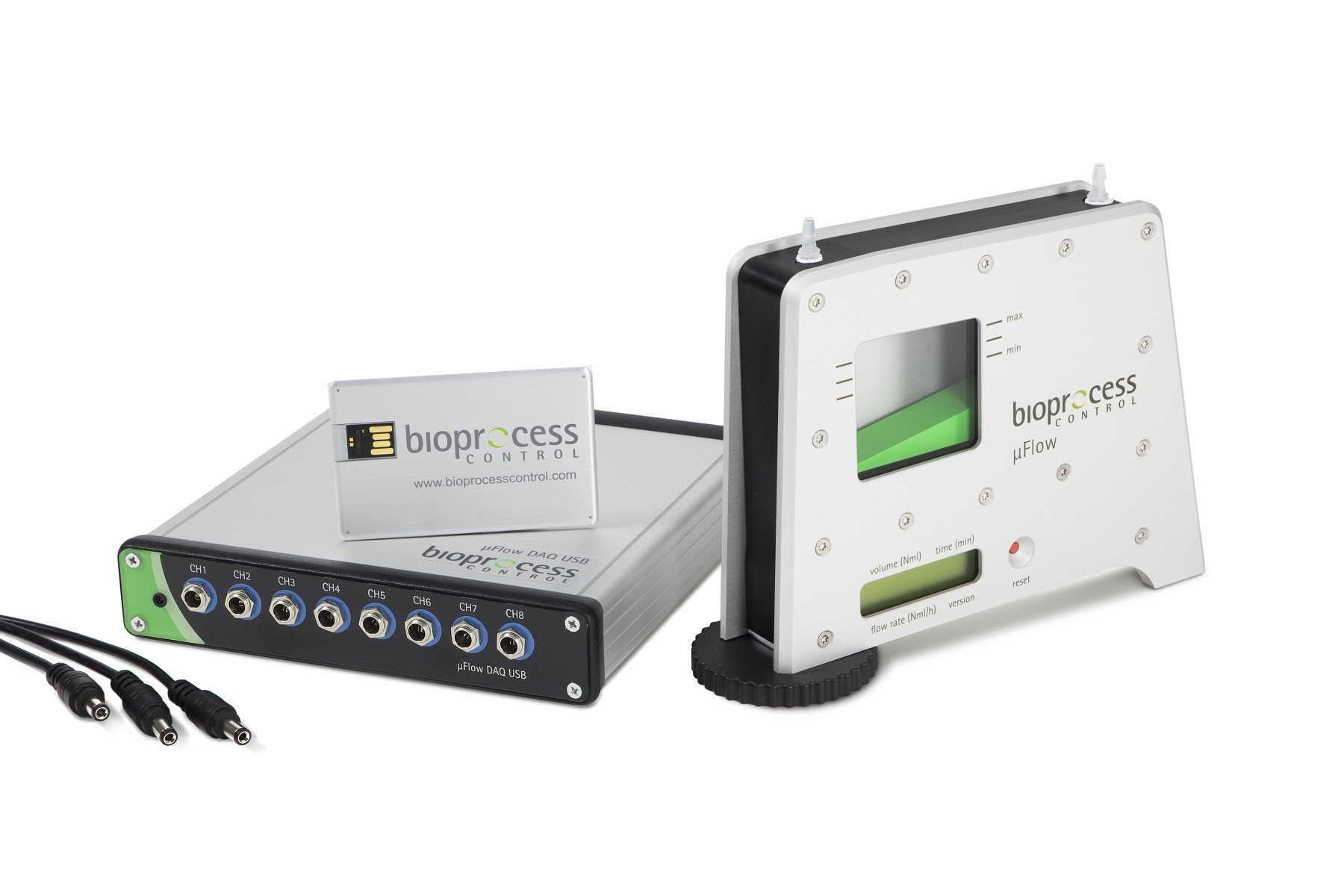采用一种特殊的激光光源,该光源工作在准连续模式之下。采用光纤振荡器和半导体泵浦的固体放大器。激光器线宽<2 GHz@1064.3 nm。10K赫兹重复频率下单脉冲能量达到150 mJ,三倍频输出的354.8 nm用于举升甲烷/空气火焰中激发甲醛,实现高速平面激光诱导荧光测量。突发式工作总脉冲数为100 和 200 幅顺序图像(分别运行在10K和20K赫兹重复频率下)。获得非稳定流体-火焰相互作用的动态图像信息。
方案详情

ResearchGateSee discussions, stats,and author profiles for this publication at: https://www.researchgate.net/publication/224708285 OPTICS LETTERS /Vol. 37, No. 8/ April 15, 20121346 Quasi-continuous burst-mode laser for high-speed planar imaging Article in Optics Letters· April 2012 DOI: 10.1364/OL.37.001346·Source: PubMed CITATIONS47 READS71 6authors,including: Joseph D Miller 67 PUBLICATIONS 774 CITATIONS Terrence R MeyerPurdue University175 PUBLICATIONS 1,993 CITATIONS SEE PROFILE SEE PROFILE . Some of the authors of this publication are also working on these related projects: Quasi-continuous burst-mode laser for high-speedplanar imaging Mikhail N. Slipchenko, Joseph D. Miller, Sukesh Roy, James R. Gord,Stephen A. Danczyk, and Terrence R. Meyer2* 'Spectral Energies, LLC, Dayton, Ohio 45431, USA ’Department of Mechanical Engineering, Iowa State University, Ames, Iowa 50011, USAAir Force Research Laboratory, Propulsion Directorate, Wright-Patterson AFB, Ohio 45433, USA4Air Force Research Laboratory, Propulsion Directorate, Edwards AFB, California 93524, USA*Corresponding author: trm@iastate.edu Received January 25, 2012; revised February 9,2012; accepted February 10, 2012;posted February 10, 2012 (Doc. ID 162086); published April 10, 2012 The pulse-burst duration of a compact burst-mode Nd:YAG laser is extended by one order of magnitude com-pared to previous flashlamp-pumped designs by incorporating a fiber oscillator and diode-pumped solid-stateamplifiers. The laser has a linewidth of <2 GHz at 1064.3 nm with 150 mJ per individual pulse at 10 kHz.The performance of the system is evaluated by using the third-harmonic output at 354.8 nm for high-speedplanar laser-induced fluorescence of formaldehyde in a lifted methane-air diffusion flame. A total of 100 and200 sequential images of unsteady fluid-flame interactions are acquired at repetition rates of 10 kHz and20 kHz, respectively. ◎ 2012 Optical Society of America OCIS codes: 120.1740,140.3538,300.2530. Understanding gas-phase combustion reactions in turbu-lent flows requires high-speed planar imaging withmulti-kHz frame rates. Metal-vapor [1] or diode-pumpedsolid-state (DPSS)) [2.3] lasers, can produce kHz-ratepulse sequences lasting several seconds or longer withenergies limited to ~10 mJ per individual pulse. Afterfrequency conversion to the ultraviolet for accessingelectronic molecular transitions, this laser energy is re-duced even further and limits the range of gas-phase che-mical species that can be investigated. The introductionof burst-mode laser technology, which included the useof repetitively Q-switched Ruby lasers [4], Nd:YAG clus-ters [5], and pulse-burst laser amplifiers [6], significantlyadvanced high-speed planar laser-induced fluorescence(PLIF) imaging of gas-phase, chemically reacting flows.These laser sources can reach energies of 100's of mJper individual pulse, but they have been limited to onlya few pulses in the case of repetitively Q-switched Rubylasers [4] or Nd:YAG clusters [5],or they have been lim-ited to a burst duration of 1-2 ms in the case of pulse-burst laser amplifiers[7]. The time dynamics of manyreacting flows of practical interest, however, can havecharacteristic oscillation periods of 3 ms or more [8],and it is important to extend the burst duration by at leastan order of magnitude to enable studies of turbulent timedynamics for a wide range of chemically reacting flows. In the current work we exceed the burst durationachieved by previous flashlamp-based pulse-burst lasersby (i) utilizing a fiber laser as the master oscillator, whichreduces the initial gain required in the amplifier chainand provides short pulses with high spatial mode qualityand low divergence; (ii) incorporating an electro-opticmodulator (EOM) that reduces amplified spontaneousemission (ASE) and is more flexible and robust com-pared to previously used phase-conjugate mirrors basedon stimulated Brillouin scattering [9]; and (iii) employinghigh gain at long burst durations with diode-pumped Nd:YAG amplifiers, which have an order of magnitude higherefficiency compared to flashlamp-pumped amplifiers and are not limited by the explosion energy ofthe flashlamps.Hence, the advantages of continuously pulsed fiber-laserand DPSS technologies are combined with burst-modestrategies to achieve an order of magnitude increase inburst duration with only a few amplification stages andreduced electrical energy consumption, resulting in asmall system footprint. The capability of this new quasi-continuous burst-mode laser (QCBML) is demonstratedby high-speed (10-20 kHz) PLIF imaging of formaldehyde(CHO), an important intermediate species in combust-ing flows [10], with burst durations of 10 ms. Becauseof the characteristics of diode-pumped amplifier stages,as discussed below, even longer burst durations of tensof milliseconds are possible with additional amplifierstages. Although not demonstrated here, the laser ener-gies achievable with this new laser architecture can alsobe used for Rayleigh scattering [11], as well as for pump-ing an optical parametric oscillator (OPO) to accessa variety of other combustion intermediates, such asCH [12], OH [13], and NO [14]. A schematic diagram of the QCBML system for PLIFimaging is shown in Fig. 1. A commercial pulsed Yb-doped fiber laser generates a continuous 100 kHz trainof pulses at 1064.3 nm wavelength with per-pulse energyof 10 uJ. The fiber-laser pulse duration is 13 ns and theline width is less than 2 GHz, allowing optimal overlapwith gas-phase molecular transitions at high tempera-ture. The utilization of a polarization-maintaining sin-gle-mode fiber results in a Gaussian beam profile withan M’ factor of 1.3. To control the pulse-train repetitionrate, the output of the fiber is collimated and directedinto a pulse picker based on a 1 MHz bandwidth EOM.The EOM is used in a double-pass configuration alongwith an optical isolator (see Fig.D, resulting in an extinc-tion ratio of 2×10. The high extinction ratio serves tocompletely suppress ASE from the fiber laser so thatthe pulse train can be effectively amplified to a high levelwithin the amplifier chain. The burst from the fiber am-plifier is then passed through a spatial filter before being Fig. 1. (Color online) Optical layout of quasi-continuburst-mode laser system. Symbols: OI-optical isolator, EOM-electro-optic modulator, PH-pinhole, HWP-half-wave plate,DWP-dual-wavelengthwave plate,QR-quartz rotator, VC-vacuum cell,HS-harmonic separator, and BD-beam dump.Numbers are focal lengths of spherical lenses. amplified in two small 2 mm diameter Nd:YAG-rod diode-pumped amplifiers. To prevent build-up of ASE, a relayoptical arrangement withh a spatial filter is placedbetween the amplifiers. To compensate for thermally in-duced birefringence, a quartz rotator is placed betweenthe two amplifiers. The pulse train is amplified by an ad-ditional 5 mm diode-pumped amplifier that is separatedfrom the initial two stages by an optical isolator and aspatial filter to avoid feedback and reduce build-up ofASE. To boost the final energy of the pulse burst, alow-gain, high-power, 9.5 mm flashlamp amplifier stageis used. For extended burst durations, this low-gain stageis a cost effective means of achieving two-fold energygain with a reasonable electrical and thermal loading. Be-cause of the high pulse energy entering this final ampli-fication stage, a spatial filter is installed inside a customvacuum cell to prevent air ionization in the beam focus.The amplifiers are fired at 0.5 Hz repetition rate to allowthermal relaxation of the Nd:YAG rods. Finally the funda-mental output is converted via third-harmonic generation(THG) to 354.8 nm by using KTP type II and LBO type Icrystals for doubling and tripling, respectively. To controlthe fundamental beam polarization for optimal THG gen-eration, a dual-wavelength wave plate is used betweenthe two nonlinear crystals. The entire optical layoutoccupies a3×2 ft’area. Figure 2 shows spontaneous emission (SE) time pro-files from the diode- and flashlamp-pumped amplifiers.SE is proportional to the amount of stored energy insidethe Nd:YAG rods and, therefore, can be used to approx-imate the amplification gain profile. Figure 2(a) showsthat diode bars can produce up to 50 ms flat gain profileat low current; however, because of a temperature-in-duced shift in the diode-bar output wavelength, the highgain is restricted to the first 10 to 20 ms. In the case offlashlamps [see Fig. 2(b)], the length of the burst is lim-ited by the power supply used, and at IIhSigh pulse energythe gain profile drops with time because of limited energystorage in the capacitor banks. Because of these limita-tions, the burst length in the current work was restrictedto 10 ms. The limitation of burst length in the case ofdiode bars can be overcome by working at lower currentand adding additional amplifiers or by carefully choosing April 15, 2012 / Vol. 37, No.8 / OPTICS LETTERS 1347 Fig. 2..(Color online) Spontaneous emission (SE) for amplifierchain as a function of time.(a) Diode-pumped amplifiers.(b) Flashlamp-pumped amplifiers. the output wavelength of the diode bars to flatten thegain profile. In the case of flashlamps, the electricalpump pulse can be extended by using a different powersupply, and the energy can be maintained by adding extracapacitor banks; however, as the total electrical pumpenergy approaches the explosion energy of the flash-lamps, a significant reduction in flashlamp lifetimemay ultimately limit this strategy [15]. Figure 3 shows the gain of the amplifiers with respectto the electrical pump energy. Note that the single-pulseenergy prior to the amplifier chain is 4 uJ and the burstduration is 10 ms. From Fig. 3(a) it is seen that the firsttwo amplifiers are initially in the small-signal gain regimeand begin to saturate at high pump current. The thirdamplifier is in the intermediate regime and the flashlampamplifier (Amp4 in Fig. 1) is completely saturated, whichis indicated by linear dependence of gain on pump energy(see Fig.3(b)) [15]. Figure 3(c) shows the laser outputenergy after amplification by factors of 1225 (Amp1+Amp2), 19 (Amp3), and 2 (Amp4). Up to 150 mJper pulse(average)is achieved in the fundamental beam at1064.3 nm. The beam is frequency doubled with an effi-ciency of 56%, but the THG step is only ~20% efficient.We attribute this low efficiency to non-optimal polariza-tion of the fundamental beam before the Type I crystaldue to the Type II nature of the KTP crystal. The outputpulse-to-pulse energy deviation is below 10% (standarddeviation) for all three output wavelengths. The suitability of the QCBML system for high-speedplanar imaging was demonstrated in a lifted CH-airdiffusion flame using PLIF of formaldehyde (CH20).The flame was stabilized over a 2 mm orifice with a flowrate of 3.06±0.05 standard liters per minute, corre-sponding to an outlet velocity of 17 m/s and a jet Fig. 3.(Color online) Amplifier-chain performance.(a) Diode-pumped amplifier gain as a function of pumping current.(b) Flashlamp-pumped amplifier gain as a function of flashlamppump energy.(C) Energy distribution in the burst at 10 kHz atfundamental, second-, and third-harmonic wavelengths. Thepulse-to-pulse energy deviation is below 10%. Fig.4.(. (Color online) 10 ms duration PLIF imaging of CH O ina lifted CH4-air diffusion flame at 10 kHz (upper panel) and20 kHz (lower panel) showing every 10th image. False-colorscales indicate non-normalized, background-subtracted cameracounts. The full sequences for 10 kHz and 20 kHz are availableonline as Media 1 and Media 2, respectively. Reynolds number of ~2000. The flame is lifted from thejet exit and exhibits a turbulent stabilization regionwhich has been the subject of numerous investigationsat low repetition rate [[16]. The excitationschemme at 354.8 nm utilized~30 mJ/pulse at 10 kHz and ~20 mJ/pulse at 20 kHz.The fluorescence signal was imaged using a PhotronSA-5 high-speed camera coupled to a LaVision dual-stagehigh-speed intensifier. A visible Nikon Noct-Nikkor55 mm f/1.2 lens was used to collect the flame imagewith amagnification of 1:4 and 82.6 um per pixel.A bandpass filter from 370-450 nm was used to remove Rayleighand Mie scatter [10]. The intensifier was operated at 67%of maximum gain with a 100 ns gate centered on the laserpulse. Two image sets collected at 10 kHz and 20 kHzare displayed in Fig. 4, showing only 10 and 20 of the 100and 200 sequential images, respectively, with full se-quences available online as media files. The laser sheetis positioned near the periphery of the jet to capture tran-sient instabilities in the flame layer. The extended recordlength allows imaging of the complete detachment andreattachment of the flame layer in the stabilization regionfor both sets of images. By comparison, other burst-modePLIF systems have demonstrated only 1 ms of recordlength [7, 17], equal to the time separating any twoimages in the 10 kHz sequence presented in Fig. 4.The typical signal-to-noise ratios (SNRs) for the current PLIF signals relative to spatial noise in the backgroundare 47:1 at 10 kHz and 40:1 at 20 kHz without pixel bin-ning. This is similar to the SNR reported elsewhere for1 ms duration, 10 kHz burst-mode CHO-PLIF images col-lected with 5×5 pixel binning and a similar field ofview [17]. In conclusion, the use of fiber and diode-pumped solid-state technology has allowed the duration of burst-modelaser imaging to be extended by an order of magnitude to10 ms, with hundreds of pulses per burst and with per-pulse energy up to 150 mJ at 1064.3 nm. This system fillsthe gap between low kHz-rate, continuously pulsed sys-tems and MHz-rate, short pulse train duration burst-modelaser systems and can monitor both low-frequencyinstabilities and high-speed reacting fluid dynamics. Be-cause the number of amplifiers in this approach is scal-able, additional low-gain diode-bar or flashlamp-pumpedamplifiers can potentially be added to increase usefulrepetition rates to 100’s of kHz and to extend burst dura-tions up to tens of milliseconds. This work was funded by the Air Force ResearchLaboratory (AFRL) under contract No. FA8650-10-C-2008 and by the Air Force Office of Scientific Research(Dr. Chiping Li, Program Manager). The authors aregrateful for the technical asfSsistance of C. Dedic of IowaState University, as well as for valuable discussions withN. Jiang of Spectral Energies, W. Lempert of The OhioState University, and I.Leyva, D. Talley, B. Kiel, M. Light-foot, and S.A. Schumaker of AFRL. ( References ) 1. G. A. Ruff, L. P. Bernal, and G. M. Faeth, Appl. Opt. 29, 4544(1990). 2. J. D. Smith and V. Sick, Appl. Phys. B 81,579 (2005) 3. I. Boxx, M.Stohr, C. Carter, and W. Meier, Appl. Phys. B 95,23(2009). 4. J. M. Grace, P. E. Nebolsine, C. L. Goldey, G. Chahal,. J. Norby, and J.-M. Heritier, Opt. Eng. 37, 2205(1998). 5. C. F. Kaminski, J. Hult, and M. Alden, Appl. Phys. B 68,757(1999). 6. P. P. Wu and R. B. Miles, Opt. Lett. 25, 1639 (2000) 7. J. D. Miller, M. Slipchenko, T. R. Meyer, N. Jiang, W. R.Lempert, and J. R. Gord, Opt. Lett. 34, 1309 (2009). 8. P. Weigand, W. Meier, X. R. Duan,R. Giezendanner-Thoben,and U. Meier, Flow Turbul. Combust. 75,275 (2005). 9. N. Jiang, M. C. Webster, and W. R. Lempert, Appl. Opt. 48,B23 (2009). 10. C. Brackmann, J. Nygren, X. Bai, Z. Li, H. Bladh, B.Axelsson, I. Denbratt, L. Koopmans, P.-E. Bengtsson, andM. Alden, Spectrochim. Acta 59, 3347 (2003). 11. R. A. Patton, K. N. Gabet, N. Jiang, W. R. Lempert, and J. A.Sutton,Appl. Phys. B 106, 457 (2011). 12. J. D. Miller, S. R. Engel, T. R. Meyer, T. Seeger, andA. Leipertz, Opt. Lett. 36, 3927 (2011). 13. J. Sjoholm, E. Kristensson, M. Richter, M. Alden, G. Goritz,and K. Knebel, Meas. Sci. Technol. 20,025306(2009). ( 14. N. Jiang and W. R. Lempert, Opt. L ett. 33, 2236 (2008) ) 15. W. Koechner, Solid-State Laser Engineering, 6th ed.. (Springer Science+Business Media, Inc., New York, 2006). 16. K. A. Watson, K.M. Lyons, C. D. Carter, andJ. M. Donbar,Proc. Comb. Inst. 29, 1905 (2002). 17. K. N. Gabet, R. A. Patton,N. Jiang, W. R. Lempert, and J. A.Sutton, Appl. Phys. B (2012). All content following this page was uploaded by Joseph D Miller on September he user has requested enhancement of the downloaded file. ◎ Optical Society of America The pulse-burst duration of a compact burst-mode Nd:YAG laser is extended by one order of magnitude compared to previous flashlamp-pumped designs by incorporating a fiber oscillator and diode-pumped solid-state amplifiers. The laser has a linewidth of <2 GHz at 1064.3 nm with 150 mJ per individual pulse at 10 kHz. The performance of the system is evaluated by using the third-harmonic output at 354.8 nm for high-speed planar laser-induced fluorescence of formaldehyde in a lifted methane-air diffusion flame. A total of 100 and 200 sequential images of unsteady fluid-flame interactions are acquired at repetition rates of 10 kHz and20 kHz, respectively.
确定




还剩2页未读,是否继续阅读?
北京欧兰科技发展有限公司为您提供《火焰,剧烈变化反应流场中高速时间分辨激光照明平面成像检测方案(流量计)》,该方案主要用于其他中高速时间分辨激光照明平面成像检测,参考标准--,《火焰,剧烈变化反应流场中高速时间分辨激光照明平面成像检测方案(流量计)》用到的仪器有PLIF平面激光诱导荧光火焰燃烧检测系统、LaVision DaVis 智能成像软件平台
推荐专场
相关方案
更多
该厂商其他方案
更多

















